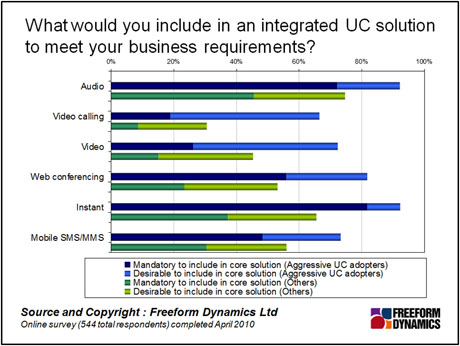As businesses strive to deal with numerous challenges, from complying with the prevailing regulatory environment to maintaining a competitive edge through customer satisfaction and loyalty initiatives, they are continually forced to re-examine the way they interact both internally and externally.
This constant re-evaluation has resulted in myriad new communication mechanisms being introduced into the business environment. Companies have long since moved beyond the traditional channels of telephone and email to embrace newer areas such as IM, audio, video and web conferencing, and SMS. But this piecemeal approach to adoption has, unsurprisingly, led to a highly fragmented communications landscape within the workplace.
A less than welcome addendum to this is that companies aren’t truly able to reap the full range of cost and productivity benefits that new communications tools ultimately promise. Moreover, this approach has resulted in a passive acceptance of fragmentation and disjoints which may not always be front of mind, but are readily acknowledged, as recent research reveals (see chart below).

This is precisely where the potential benefits of unified communications (UC) can be relevant, as a set of tools to bring this fragmented environment together in a coherent and structured way. But although UC is often thought of as a broad solution set – and in point of fact, this all-encompassing term does it no favours – it actually comprises a number of distinct components, including unified messaging, unified directory, presence and rules-based routing.
When companies think in terms of these individual components, the relevance of UC becomes much clearer and more meaningful. To date, however, adoption of UC in any broad sense is relatively limited, with most adoption focusing around unified directory. But businesses are starting to evaluate UC much more now, or at least have it on the agenda.
As these companies move forward, a key question they face is the extent to which they implement UC. Given the seeming lack of surety around the benefits, the tendency might well be to go for a partial approach and build this up over time, e.g. beginning with unifying the various directories that exist across the business, to minimise risk and capital outlay, and then perhaps bringing in unified messaging or single number at a later stage.
However, Freeform Dynamics’s research shows there is, in fact, a ’multiplier effect’, meaning the overall value of a comprehensive UC solution is greater than the sum of its parts. Moreover, when considering the question of scale of implementation, its value appears to grow when more users are involved in a deployment.
UC implementations delivering the greatest value tend to be those that include a wide range of functionality and are rolled out broadly across the business. This suggests that in fact, while a cautious, baby-steps approach to UC might be a preferred option for many companies, in order to reap serious benefits, businesses should go for a much more aggressive approach. Where a slower approach is necessary, it is much better to consider comprehensive UC in, say, one department, rather than partial UC (e.g. unified directory) across the whole of the business.
But there is another interesting take away from this research. When we think about the various communications mechanisms, not all have gained equal traction in the workplace. Certain ones – video communications for example – have generally experienced a lukewarm response when considered in isolation. The overlay of UC in a broader, more aggressive way, however, has a very interesting effect, as is clear in the chart below.

What we find is that communications options that many would not see as attractive enough to implement in isolation are much more readily embraced when they are seen as a component or ’option’ within a broader communications product such as UC.
For buyers and users who are formulating or reviewing their plans around UC, it is worth taking note of the impact that UC can have on individual communications solutions. For example: while users may not be inclined to log into a separate video communications system, based on an unfamiliar call-initiation approach, when making a video call is a couple of clicks away in a UC context, they use the feature.
The outcome of this is that implementation of UC potentially allows an organisation to take greater advantage of emerging mechanisms such as video communications, web conferencing and IM to boost workforce and process efficiency and effectiveness.
UC can bring genuine benefits into the business. However, to truly realise its full benefits, a broader set of UC components will have a greater impact on the business. This is true whether you are planning initial activity, a pilot or a full-scale rollout. It is much better to aim for a richer set of capabilities from the outset, rather than focusing on individual functions that will always have limited value when deployed independently.
Content Contributors: Josie Sephton